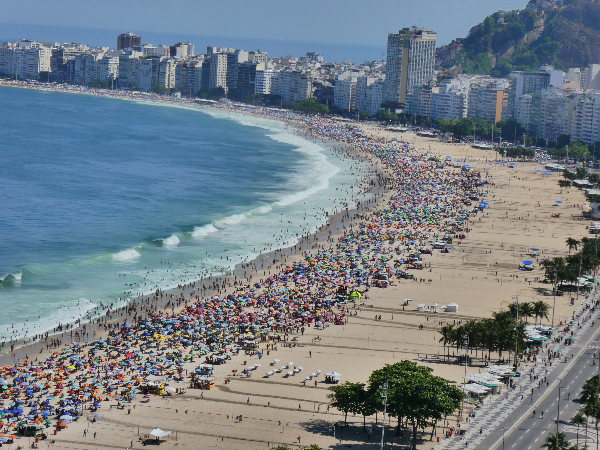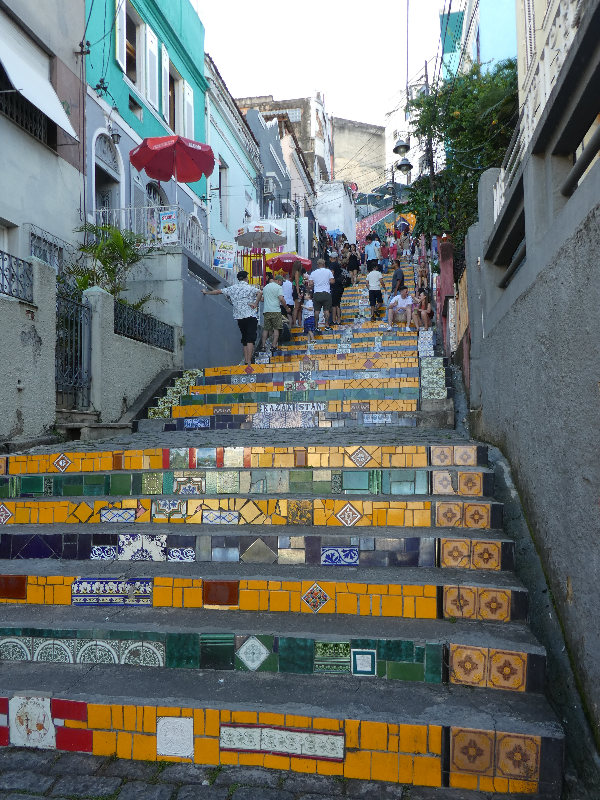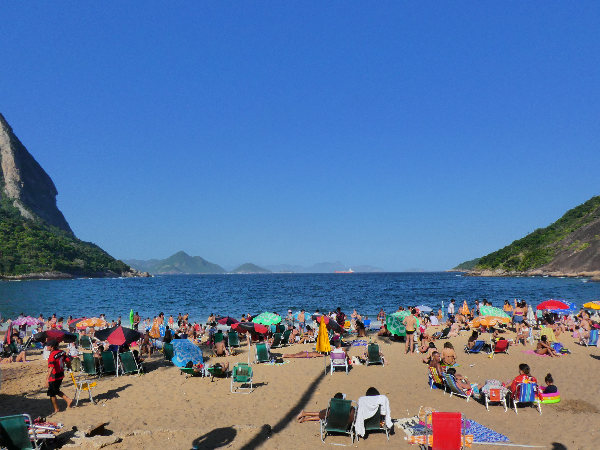Rio De Janeiro is famous for the statue of Christ the Redeemer, beaches such as Copacabana and one of the best carnivals in the world. Yet, somehow, it wasn’t high on my list of places to visit. Brazil isn’t very high on the list of UK holiday destinations.
I didn’t think I would enjoy Rio de Janeiro that much. I get bored of just sitting on the beach, and in Rio, the sea is often a bit too rough for swimming. I am not into the party scene, so I didn’t think Rio would be my type of place. But as often happens when I go to places I didn’t think I would like, when I get there, I really enjoy them.
The Carnival
The carnival begins on the Friday before Lent and ends on Ash Wednesday. In 2025, it was from 28th February to 8th March. The prices to watch the parade vary from £20 to £362 per day. It depends on whether you want to stand, sit on stone steps, have a seat with a cushion, have reserved seats, be undercover in case it rains, and where along the route you are.
You also have a choice of the type of parade you watch: Access Group is a less famous Samba schools, Special Group is the best and most famous schools, and Champions Parade has the Champion school and five runner-ups from the Special Group parades. There is also a children’s parade.
The Carnival is more than just a parade; numerous street parties (blocos) occur in the weeks surrounding the main parades.
During this period, Rio de Janeiro is hectic. It is the most famous parade in the world and draws large crowds. The hotels are more expensive and noisy, even in the early morning. The restaurants are crowded, the chances of having your things stolen increase, and transport can be a nightmare. However, this should be on top of your bucket list if you are into the party scene. You will need to book tickets and hotel reservations very early.
We chose to go to Rio at a quieter time; however, some friends visited the parade while on a cruise, and this seems like a good idea for those who want to see the parade but avoid the queues and hectic conditions. They enjoyed the parade but still had to wait hours as their coach had difficulty finding a road open that would take them back to their port.
Christ the Redeemer (Corcovado)

You can spot Christ the Redeemer from miles away, but it is worth making an effort to get up close. To avoid the crowds, go on a weekday, in the off-season, and very early, preferably all three. We went at 9 a.m. on a weekend in spring, and it was heaving with people at the top. You have to push through any gaps you can make in the swarming mass of people.
If you want to go when there are fewer people, go as soon as it opens at 8:30. There could still be lots of people, but moving around will be a bit easier.
If you want to take a good photograph, then going in the morning is better for taking a photo of Christ the Redeemer and in the afternoon if taking a photo of the view below, due to the sun’s position.
They sell skip-the-queue tickets, but I have heard many complaints that people still get put in a long queue or that the ticket only works when you are going up the mountain, not coming down.
The queue getting up and down can be very long, but they move at a steady pace. The biggest problem is the crowds at the top. When we went, we had booked a ticket in advance for 9 a.m. and were put in a shorter queue than those who had just turned up and paid at the entrance.
You can take a minibus or a funicular train to the top, or if you are super fit, you can walk up, but it is not recommended, especially near dusk. The trip by funicular takes 20 minutes and stops for a few moments halfway up. A young man sells water bottles here, but the passengers are more interested in the monkey playing in the jungle tree behind him. Going by shuttle bus can be slightly cheaper, but you won’t get the lovely views.
At the top, you can see the details of Christ the Redeemer, which is 98 feet tall, not including the pedestal. You can get to Christ the Redeemer from the top of the funicular by lifts or escalators. A little chapel, toilets, and a café are around the back. We usually avoid cafes at tourist spots as they are wickedly expensive, but this one wasn’t too bad. You might have problems finding a spare seat, especially in the shade, but sitting on a couch eating, drinking, and watching the world below was a lovely treat.
If you are visiting during peak season, it might be wise to book tickets in advance but check the weather beforehand. You won’t see much if it is cloudy. Sometimes, it can be hazy in the morning, but it burns off, leaving good views.
Sugar Loaf

Another major attraction is the Sugar Loaf. From the top, you see fantastic views below. People like to take photos of Christ the Redeemer at sunset from here. However, our photos weren’t great; there were many ugly masts between Christ and the sun setting.
You get to the top of Sugar Loaf Mountain by cable car. First, you go to the top of Moro da Urca, and then you get a second cable car to take you up to Sugar Loaf Mountain. Once you are up, there is more room for the crowds, though expect to find many people around the viewpoints to see the sunset.
At both stages, there are shops, cafes and toilets.
The queue going up and down by cable car can be very long, especially around sunset. It is much slower moving than the queue at Christ the Redeemer. When we went, the queue to go up at both stages was 1 to 1 ½ hours long and coming down looked worse.
We opted for fast passes at the Sugar Loaf. They weren’t cheap, but if you are going during a busy period, they are worthwhile, especially if you can’t stand for long periods or have young children.
Copacabana and Ipanema

Of course, you can’t go to Rio without seeing at least one of the two main beaches, Copacabana and Ipanema. Both beaches are close, with an 8-minute walk between them.
Copacabana Beach is a 2 ½ mile crescent beach. Running beside the beach is a black-and-white pavement with a wavy pattern. Walking along this promenade is a popular pastime, especially when the weather is cooler. There is also a cycle/running path. I was surprised at how many people running looked old enough to be in retirement homes, and a couple of them looked like they would keel over any second.
The beach is very attractive. Tall green mountains surround the area, and large prehistoric-looking birds fly overhead. At one end of the beach is a small hill surrounded by a jungle with a fort at the top. Beyond the hill is Sugar Loaf Mountain. Looking the opposite way down the beach, Christ the Redeemer is on the mountains above with his arms outstretched, looking down on the people.
Ipanema is 1½ miles long and very similar to Copacabana. It has chic shops nearby, which is considered a little more upmarket.
On both beaches, if you need a cool drink, there are plenty of cafes and vendors selling souvenirs. A series of lifeguard posts have toilets and showers for a small fee. There is a gay section on each beach; they have a huge pride flag, so you can’t miss it. There are flood lights on all night, but I wouldn’t recommend going to the beach at night for safety reasons.
The sea can be rough, and the waves crash down, so swimming isn’t possible. You get crowds on the beaches during the summer, which can be very noisy, especially on Sunday afternoons.
Pedra do Arpoador is a rocky outcrop between the two beaches. On clear days, people gather here to clap as the sun sets. You can get lovely photos of the Two Brothers Hills (Morro Dois Irmãos).
This is also near the area where people like to surf.
Escadaria Selarón

This is where an artist started putting tiles up by some steps near his house. When people discovered he was trying to improve the place, they contributed more tiles. There are over 2000 tiles from 60 countries across the world.
I found it interesting to spot all the different tiles from around the world and the odd, quirky tiles, like the Simpsons.
The place is crowded, so if you can, go early before the coach tours arrive. Once the crowds arrive, it isn’t easy to see the tiles.
Botanical Garden
The botanical garden is the ideal place to escape the noise. It costs about £10 to enter, and you will need cash unless you can access Brazil’s instant payment system, Pix. The gardens get mixed reviews, as some visitors are disappointed when flowers are not at their best. You have to remember that the plants are real, and if you go out of season, the plants can be disappointing.
Be careful if it has rained the day before, as it can get slippery. You might want to take some insect repellent. Pick up a map at the entrance. You can use a hop-on/hop-off train to get around the gardens for an extra charge.
Look out for the orchid house.
Forte Duque de Caxias

This small, free fort above Copacabana Beach has excellent views. Finding the entrance to the path can be tricky. It is at the end farthest from Ipanema Beach and starts beside an army barracks. Along the barrack wall, there is an entrance with a small car park beyond it. Go into the car park, keep walking by the wall on your left, and you will soon find a path going up. Don’t be surprised to see the armed soldiers.
The path is hard work all uphill and takes about 25 minutes, plus stops to take photos of the marmosets. There are toilets and a water fountain at the top, but I would take your own water as it didn’t look like a reliable source.
Other places

There are many other places to visit, depending on your interests. Maracanã is the world’s biggest football stadium. You can go to a match or take a tour around the stadium.
Museu do Amanha is a science museum with incredible architecture. Tickets are £4, but if you are over 60, they are free, and for university students, they are only half the price.
If you can cope with getting up early in the morning, you can take photos at sunrise looking towards the sugar loaf. We got a guide to take us to Mirante Dona Marta, which was full of people taking selfies. You can also get a good view of Christ the Redeemer from here. If you get dropped off by a taxi, make sure you arrange for them to pick you up again, as there isn’t a good reception.
There are also small beaches, such as Praia Vermelha, near the Sugar Loaf cable car. Mountains surround this pretty beach. If you head out to other smaller beaches by taxi, ensure reception so you can request a taxi back.
Rio is a good stepping stone to fly to other places in South America if money allows. We went to Iguazu Falls, the largest waterfall system in the world. You could also go to Sao Paulo.
My hotel
When I wasn’t sightseeing, my favourite thing to do was bob in our hotel’s rooftop swimming pool, which had a bar and a café next to it. From there, I had a fantastic view of Copacabana Beach. It is worth considering doing similar as you can’t swim in the sea and the beach can get very crowded and noisy at times. This is one of the places I thought was worth spending more money for a good view.
We stayed at a couple of different hotels in Rio de Janeiro to fit in with our travel plans. There is no point splashing out on expensive hotel rooms if you are out sightseeing all day. But if you are relaxing, consider a pool with a view worth it.
Food

You shouldn’t have any trouble finding food you like. For fussy children, you can find McDonald’s and pizzas or fine dining for adults.
Vegetarians are well catered to despite Brazil being the second-largest beef producer in the world. 18% of Brazilians are vegetarians (11% in the UK), and the number is growing quickly.
Food to look out for is barbecue food. Try all you can eat restaurant and take a big appetite.
Coxinha is a drumstick-shaped deep-fried dough filled with shredded chicken, sometimes cheese, and many spices.
Feijoada is a black bean stew with pork or beef cooked slowly.
Pao de queijo are small balls of cheesy bread.
Brigadeiro are tiny balls that resemble truffles. They are made of condensed milk, butter, and cocoa powder and rolled in sprinkles. They are usually chocolate or coconut-flavoured, but you can get them in all sorts of other flavours.
How safe is it?
Rio de Janeiro has a lousy reputation for theft and pickpocketing, which is especially bad during the carnival. However, we always felt safe and found police present when we were out in the dark, watching the sun go down at the beach.
I would increase your normal precautions slightly, but don’t worry about it.
Don’t walk up to Christ the Redeemer statue, as there have been armed robberies there. On the beaches, don’t take anything you would be upset about losing. Sometimes, gangs steal things quickly and disappear before anyone can react. Don’t walk along the path at Copacabana Beach with your bag over your shoulder; thieves on bicycles frequent the area.
It is essential to know where the Favelas (slum) areas are and avoid them. They are dangerous areas, and a tourist was shot in one. The shanty towns can be obvious in other cities, but in Rio, they are among the other buildings and some near tourist areas. I could see one from our Copacabana beach hotel.
Even costume jewellery has been snatched from tourists’ necks. We avoided going out much at night, but when we did, we stuck to lit areas and avoided isolated shortcut paths. When we needed to get our phones out to request a taxi, we stood at the entrance of a hotel or restaurant.
Summary
Rio is enjoyable, and there is much to offer tourists. With two very popular attractions, it is essential to plan your trip well. Both Christ the Redeemer and the Sugar Loaf are best with clear weather, so don’t have such a tight schedule that you have no wiggle room to change your plans.
Listen to a little samba as you relax on a sunbed, visit one of its lovely churches or go for a stroll along the beach path; whatever you do, you are sure to wonder why more people from Europe don’t have Rio de Janeiro higher on their wish list.

Leave a Reply